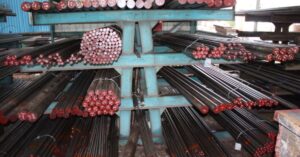Tool Steel Machinability and Cutting Performance
Introduction
 Tool steels refer to a variety of alloy steels specifically engineered for manufacturing cutting, forming, and shaping tools. Their high hardness and unique properties provide excellent durability and longevity for tooling applications.
Tool steels refer to a variety of alloy steels specifically engineered for manufacturing cutting, forming, and shaping tools. Their high hardness and unique properties provide excellent durability and longevity for tooling applications.
However, the same properties that give tool steels outstanding performance also make them challenging to machine and grind. The hard carbides, treatment conditions, and alloying additions that provide strength, wear resistance, and other characteristics negatively impact machinability.
This article provides an in-depth examination of tool steel machinability factors, cutting tool performance, best machining practices, innovations, and methods for overcoming the difficulties of machining these crucial tooling materials.
Definition of Machinability
Machinability refers to how easily a material can be cut, drilled, ground, or otherwise machined. Key factors include:
- Cutting forces required
- Tool life attained
- Cutting speeds and feeds possible
- Quality of finish produced
- Chip formation and breaking characteristics
- Grinding performance
Materials with good machinability enable easy, quick, and low cost machining processes. Tool steels present challenges in most of these regards.
Tool Steel Properties Affecting Machinability
The unique properties of tool steels that give outstanding tool performance also impede machinability:
Hardness
- The high hardness (50-70 HRC) of tool steels requires significant cutting forces and causes rapid wear on cutting tools and grinding wheels.
Toughness
- The moderate toughness of tool steels makes precise cutting more difficult and energy intensive. The alloys resist deformation and cutting.
Alloy Carbides
- Hard particles of vanadium, chromium, molybdenum and tungsten carbides cause extreme abrasion on cutting edges and grinding wheels.
Heat Treatment Condition
- The quenched and tempered condition of tool steels contributes to their hardness, strength and poor machinability.
As a result, machining tool steel is 100 times more difficult than low carbon steel. Careful process planning is required.
Major Tool Steel Machining Methods
The primary processes used for machining tool steels include:
Turning
- Performed on lathes
- Carbide insert tooling utilized
- Lower speeds and feeds required than for other materials
Milling
- Milling operations to shape components
- Indexable carbide end mills needed
- More challenging due to interrupted cuts
Drilling
- Drilling performed with carbide drills
- Peck drilling required to clear chips
- Slower speeds and rapid wheel wear experienced
Grinding
- Abrasive grinding to achieve final dimensions and surface finish
- Hard bonded wheels mandatory; diamond sometimes used
- High wheel wear compared to other alloys
Wire EDM
- Electrical discharge machining to erode material
- Does not contact the surface so hardness not an issue
- Provides excellent finish
Additional Processes
- Planning, broaching, and other processes also utilized when feasible
- Carbide tooling essential for reasonable life
Tool Steel Cutting Tool Performance
The cutting tools utilized must withstand the rigors of machining the tool steels themselves:
Carbide Tools
- Carbide grades with high hot hardness like C5 and C6 recommended
- Higher cobalt content provides increased strength and wear resistance
Tool Geometry
- Positive rake angles around 7-15° work best
- Refined edge preparations improve cutting performance
Coatings
- TiAlN, TiCN and other ceramic coatings provide lubricity and edge protection
Tool Life
- Carbide tool life is still relatively short compared to cutting easy alloys
- Focus is on optimizing cutting parameters within tool life constraints
Tool Forces
- Cutting and feed forces are higher than when machining carbon steels
- Stout toolholders needed to resist deflection under forces
Careful cutting tool selection and application is key to cost-effective tool steel machining.
Recommended Cutting Parameters for Tool Steels
Some general guidelines for effective tool steel machining include:
Cutting Speeds
- Turning/boring speed range of 100-300 SFM
- Milling speeds from 100-200 SFM
- Drilling speeds of 10-30 SFM
Feeds
- Light to medium feeds around 0.003-0.012 IPR turning/boring
- 4-12 IPM milling feed rates
- Slow drill feeds of 0.001-0.003 IPR
Depths of Cut
- Light to medium depths of cut, 0.020-0.100″ typical
- Deeper cuts increase forces, limiting achievable tool life
Coolants
- Soluble oil or synthetic coolants provide lubricity and chip flushing
- High pressure flow directed at cutting zone
- Through tool delivery ideal for drilling and boring
Following recommended cutting parameters maximizes productivity when machining tool steels.
Additional Tool Steel Machining Guidelines
Some other helpful tips for machining tool steels include:
- Take light finishing cuts to minimize distortion
- Allow time for carbide tool heating and gradual wear in
- Employ slow jog feeds to protect the edges
- Use peck drilling and chip breaking in deep drilling
- Monitor tool wear and replace inserts regularly to avoid big crashes
- Consider rough machining prior to heat treatment when feasible
- Grind to final dimensions when the highest precision is needed
- Utilize EDM for difficult features or hard-to-machine grades
- Vacuum clamping improves hold down for precision grinding
Applying these kinds of best practices results in improved machining productivity.
Advanced Machining Methods for Tool Steels
 In addition to conventional machining, some advanced methods are especially helpful for tool steels:
In addition to conventional machining, some advanced methods are especially helpful for tool steels:
Abrasive Waterjet Cutting
- High pressure abrasive waterjet cutting avoids tooling challenges
- Provides good edge quality and geometric cutting capability
Wire EDM
- CNC wire erosion cuts with electrical discharges
- Not affected by hardness and leaves excellent finish
Laser Cutting
- High power laser cutting melts and vaporizes material
- Allows intricate contours unachievable otherwise
Precision Grinding
- Utilizes superabrasive CBN and diamond wheels
- Achieves fine surface finishes and tight tolerances
Cryogenic Cooling
- Uses liquid nitrogen to freeze and embrittle material
- Reduces cutting forces and tool wear for easier machining
Applying advanced techniques expands the possibilities for tool steel machining.
Improving Tool Steel Machinability
Some strategies can improve machinability of tool steels:
Annealing
- Soften the tool steel by heating and slow cooling
- Allows easier machining but properties must be redeveloped via heat treatment
Hot Machining
- Cutting at elevated temperatures softens the steel
- Requires special setups and temperature control
Alloy Modification
- Adjusting composition can aid machinability but may sacrifice other properties
Non-Metallic Inclusions
- Adding controlled amounts of sulfides improves chip breaking
Machinability Enhancing Coatings
- Special PVD coatings like Tecrex can improve tool performance
In highly demanding applications, these kinds of approaches may provide benefits.
Tool Steel Machining Cost Considerations
The difficulties of tool steel machining result in increased costs:
- Slow metal removal rates require more machine time
- Frequent tool replacement and dressing leads to higher tooling costs
- Increased wear on machine components from higher cutting forces
- Extensive benchwork needed for precision grinding and fitting
- Additional expenses associated with wire EDM and other processes
These factors result in tool steel machining costs typically being 3-5 times higher than easier to cut alloys like aluminum or mild steel.
Summary of Tool Steel Machining Characteristics
In summary, the key points regarding tool steel machinability:
- The high hardness, strength, and alloy carbides impede cutting and grinding
- Carbide tools with specialized coatings and geometries are mandatory
- Much lower speeds and feeds are required compared to other materials
- Tool life remains short, necessitating frequent insert replacement
- Advanced processes like EDM and precision grinding are widely utilized
- Machining costs are considerably higher due to intensity of tooling wear
Careful process planning and tool selection allows efficient machining to achieve final tool steel component dimensions and surface finish.
Frequently Asked Questions
What are the main differences in machinability between tool steels and plain carbon steels?
The hardness, strength and carbides in tool steels necessitate lower speeds and feeds, heavier cutting forces, and shorter tool life compared to plain carbon steels which can be machined quickly with simple high speed steel tooling.
What cutting tool grades provide the best performance in tool steels?
Carbide grades with high hot hardness like C5 and C6 with specialized ceramic coatings like TiAlN or TiCN generally provide the best combination of tool life and cutting efficiency.
What cutting speed is typically used for turning hardened tool steels?
Turning speeds for tool steels generally range from 100-200 SFM for finishing and somewhat higher for roughing. Much lower than the 500+ SFM used for aluminum or mild steel.
What cooling strategies help overcome the challenges of tool steel machining?
High pressure soluble oil or synthetic coolants provide critical lubricity at the cutting interface. Through tool and high volume flood cooling improves heat transfer.
How much more expensive is it to machine tool steels compared to easy to cut materials?
The intense tool wear and slow speeds needed result in tool steel machining costs typically being 3-5 times higher than machining free machining steels or aluminum alloys.
I hope this guide provides helpful knowledge on effectively and efficiently machining these challenging but extremely useful materials! Please let me know if you have any other questions.

